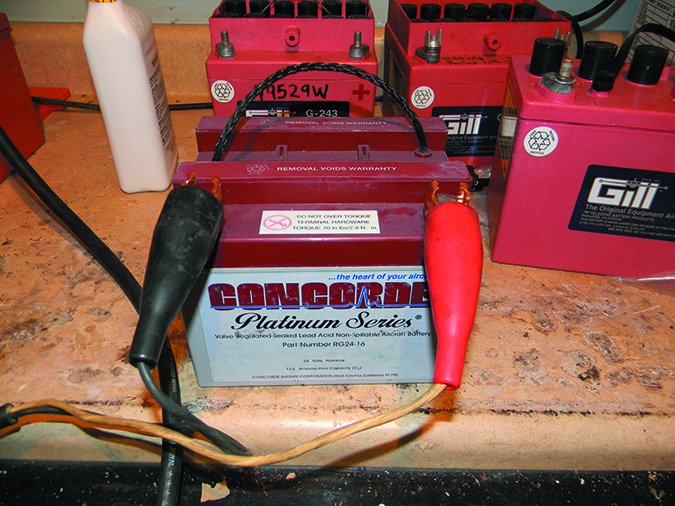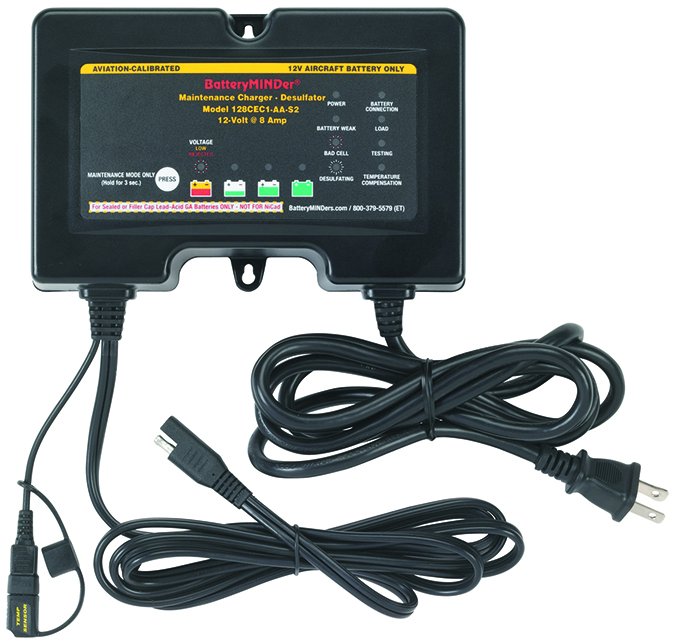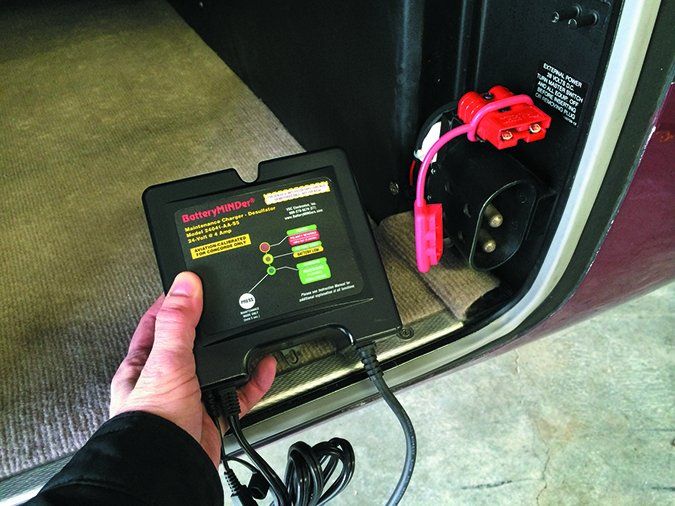As technicians, we know for certain that pilots have problems maintaining the health of aircraft batteries, with expensive consequences. If you’re among the crowd that buys a new one every two years—or sooner—you know that a new battery will set you back at least $165 for a Gill flooded model to we’ll over $200 for a Concorde sealed model. These are entry-level prices that don’t include labor.
While aircraft batteries endure more abuse than their automotive counterparts, there are some things you can do to ensure the battery will last longer—and won’t leave you stranded on a cold, dark ramp. In this article, we’ll look at what you can do to keep this critical accessory in top shape.
Charging, Testing 101
The reason folks have problems with batteries—and it is not just aviation batteries—is because they really don’t understand them, or even know how to properly test them. Moreover, with so many items using batteries these days, we have been conditioned to think that any battery has a nebulous and mysterious life-span and that when it gets weak or quits entirely, it’s a throwaway item. Not so. First, some essential basics on charging an aircraft battery.
Batteries store electricity in a chemical form and depend on the reaction between lead plates and the electrolytes. The energy is stored in each cell and is discharged when a draw is applied to the battery. A battery will not create electricity, so any energy stored in the battery has to be placed there by a charging device. A battery can be slow-charged or fast-charged and even “kicked” with a high amount of charge to promote starting. A long, slow charge using a charger that is specific to the type of battery is optimal because it can compensate for temperature, the rate of charge and allow for the conditioning of the battery.
Chargers made specifically for aviation batteries allow for the higher concentration of electrolytes used in them, plus they charge at a much lower rate than automotive chargers and with a more regulated voltage.
Most lead-acid batteries take longer to charge than you might think. Usually, a solid eight hours is required for a full charge. How do you know when it’s charged? Consider that the traditional way to test a battery’s state of charge is with a hydrometer. It’s tempting to use, but consider that a VU meter/tester will only reveal the battery voltage.
The proper testing procedure is to fully charge the battery, allow it to sit for 12 hours at room temperature (around 75 to 77 degrees is best) and test it with a hydrometer that has also been at room temperature. Cold balls inside the device can give false readings.
Battery Type Matters

You should also understand some of the major differences between the two major types of aviation batteries. While many non-specialty batteries are lead acid, in aviation we have both flooded lead-cell batteries and sealed batteries. In general, the Gill aviation battery manufactured by Teledyne Battery Products is a vented, flooded lead-acid battery. You can actually see the cells by removing the caps.
Batteries made by Concorde are called sealed or AGM (absorbed glass mat) and have a maximum number of lead plates and electrolyte content stored in the same space. Concorde says the cells are sealed with pressure relief valves that keep gasses inside the battery. The plates are sandwiched between layers of fiberglass mat. In general, sealed batteries are more tolerant of periods of inactivity.
In both types, there are cells where the energy is stored, and these are filled to the proper level (which is the split ring on the flooded battery) with electrolyte, a mixture of sulfuric acid and distilled water. While the Concorde sealed battery is considered maintenance-free, don’t think that it won’t require proper and periodic servicing. It still has to be maintained and most importantly, correctly charged.

A flooded battery will have caps that are vented, allowing gas to escape when the battery becomes too hot from both charging and ambient temperature. If the battery is being overcharged (a common mistake), then distilled water generally needs to be added every three to four months to keep the cells submerged and active. A sealed battery can also overheat, and there are vents built into the case to help counteract. the condition. However, there is no replenishing the water. For that reason, consider that it’s only maintenance free if the average ambient temperature is moderate, say, below 77 F. And it’s about temperature and controlling the rate of charge. Simply apply a charge at a relatively slow rate until its capacity is reached, and then keep the battery warm, but not hot.
Batteries are sensitive to temperature and perform best when warm. Additionally, a battery will not take a charge when it is too cold. Ever have a dead battery on a cold day, get a power cart start and then go for a quick trip around the pattern or sit idle in the runup area, thinking that it’s charging up? In many instances, that just isn’t enough.
One trick to warm up a battery in cold temperatures is to first apply a draw to a battery. Turn on the pitot heat, the landing light or even crank the engine. Preheating the battery, of course, is best.
How We Kill Batteries
Just sitting—as our airplanes often do for longer than we would like—a battery will naturally discharge a bit every passing day. Use caution when trying to help it out. Connecting the battery to an automotive battery charger on a hot day could cause it to boil, losing water out of the electrolyte. You can see this with the caps off of a flooded battery. Look closely. If all but one cell is bubbling merrily, the slow one is likely a dead cell.
Worth noting is that Concorde says the popular Deltran Battery Tender product (commonly used on automobile, motorcycle and marine batteries) should not be used with its aircraft batteries because the charging voltage is set too high.
But doing nothing at all is a killer, too. It’s when a sitting battery is completely ignored that the real problems begin. Don Grunke, an electrical engineer with Concorde Battery Corp., told us that the simple key to long battery life is keeping it fully charged. Sounds easy, right? Wrong. What he means is it must be cycled, charged and discharged, kept relatively warm and never stored in a discharged state.
That’s because a discharged battery will begin to sulfate. While it’s not uncommon for crystals to form, these are usually harmless—unless the battery is stored in a discharged state. Lead sulfate will convert to crystalline deposits on the negative cells. Larger crystals will form and eventually short out the plates. If the electrolyte is allowed to evaporate, usually by overcharging, and the plates are dry, they will permanently sulfate. This results in a dead cell, a weak battery that cannot charge to capacity and generally, one that will not crank an engine enough to get it started. Then it is time to replace it, and without the proper maintenance, this vicious cycle starts over.
BatteryMinder: Simple, Smart, Safe
There are all sorts of battery management devices on the market (generally called battery tenders), but very few are aviation specific. Many owners go the cheaper route and use an automotive battery charger or trickle charger. For a long time this was the main reason aircraft batteries failed at a high rate. Then Bill Woods at VDC Electronics brought the BatteryMinder product to the market. In our estimation, this could be the answer to longevity (perhaps four times the life) and optimal cranking power for any rechargeable lead acid or gel battery.

The latest-generation BatteryMinder—which was announced at this year’s AirVenture—is the most advanced model yet, with a feature set that’s been simplified for one-touch operation. The device can be used when the battery is out or installed in the aircraft, using a quick-connect harness.
Like previous BatteryMinder models, the CEC1-AA smart charger is calibrated specifically for aircraft use, which is different enough from automobile chargers to be consequential. Using lighted icons on the face of the device, the BatteryMinderer shows the condition of the battery’s charge, plus it charges at a rate that compensates for temperature. Also, it automatically cycles into a maintenance mode, which is concurrent with desulfating the battery.
The device is available for use with 12- and 24-volt batteries and there are three specific models appropriate for Concorde, Gill and Hawker-Odyssey batteries. The device can be used to maintain multiple batteries at the same time when connected in parallel with the model BC2AY fuse-protected accessory.
Using the device is simple. Connect it to the battery and then plug it into a wall socket and observe the annunciators on the face. The first battery icon indicates the battery is fully discharged, evident by a steady amber light or flashing red light, which indicates zero volts. The second icon to illuminate indicates that the battery is constant-current charged to 80 percent. When the battery reaches full capacity, the solid green icon illuminates, and the device maintains and desulfates it indefinitely. There is even an annunciator that senses a load/draw on the battery, plus one to indicate that there’s a bad cell. The device sells for $240.
Charging Systems
As we discuss above, the absolute best way to keep a battery healthy while you aren’t using it is to connect it to a smart charger. But in some aircraft, that could mean lengthy disassembly every time you want to connect it.
Lexington, Kentucky-based Advanced Flight has a PMA-approved quick-connect plug that’s compatible with the VDC Electronics BatteryMinder line. Have your shop wire the harness to the battery and terminate the connector in a convenient location on the airframe. When installed per the instructions, it’s considered a minor alteration and can be signed off with a logbook entry. The BM-ALK2 kit is priced at $69.95.
Finally, don’t underestimate the damage a faulty charging system can do to your battery. We’ve seen many owners insist on changing battery after battery when it was the charging system that needed attention, only because swapping a battery was easier.
If the bus voltage is too low (maybe the voltage regulator is improperly set), the battery will never charge to its full capacity. As a rule of thumb, a 12-volt battery needs a bus voltage of 14 volts to reach and maintain a fully charged condition. A 24-volt battery really needs roughly 28 volts.
Overvoltage can be worse than undervoltage, especially for a sealed battery. We witnessed a Concorde battery self-destruct when the charging system in a Cessna 210 reached nearly 30 volts, and stayed there for a multi-hour trip at cruise power.
How do you know what the bus voltage is? Most modern engine monitors display it, as do some panel avionics systems.
If you don’t want to chase fluctuations in charging system output, our advice is to stick with a flooded battery type and deal with associated maintenance that tags along.
Last, how much life can you expect from a properly maintained aircraft battery? As you can tell from reading this article, there are many factors and it’s just impossible to say for sure. We’ve seen airplanes—in cold climates—with batteries that haven’t been changed in five-plus years. Those batteries may be on borrowed time, but they’ve also been cared for. Look for a report on a battery brand satisfaction survey in a future issue of Aviation Consumer.
Contributor Jim Cavanagh is a freelance author and aircraft owner who has rebuilt nearly a dozen airplanes. In the process, he’s maintained a few batteries, too.


